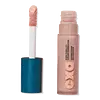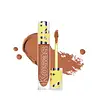Exa Beauty High Fidelity Balancing Color Corrector Versus Kosas Revealer Extra Bright Serum-Powered Color Correctors
What's inside
What's inside
 Key Ingredients
Key Ingredients

 Benefits
Benefits

 Concerns
Concerns

 Ingredients Side-by-side
Ingredients Side-by-side

Water
Skin ConditioningCoco-Caprylate/Caprate
EmollientPropanediol
SolventCaprylic/Capric Triglyceride
MaskingCetearyl Ethylhexanoate
EmollientC12-15 Alkyl Benzoate
AntimicrobialTriheptanoin
Skin ConditioningGlycerin
HumectantCoconut Alkanes
EmollientHydrogenated Castor Oil
EmollientPolyglyceryl-3 Diisostearate
EmulsifyingDiisostearyl Malate
EmollientKaolin
AbrasiveDilinoleic Acid/Butanediol Copolymer
Stearalkonium Hectorite
Gel FormingPolyglyceryl-6 Polyricinoleate
EmulsifyingPolyhydroxystearic Acid
EmulsifyingPolyglyceryl-3 Polyricinoleate
EmulsifyingBrassica Campestris Seed Oil
Skin ConditioningGlycyrrhiza Glabra Root Extract
BleachingOryza Sativa Bran Extract
Skin ConditioningAlthaea Officinalis Root Extract
Skin ConditioningSaccharomyces Ferment
Skin ConditioningTocopherol
AntioxidantLecithin
EmollientCetearyl Olivate
Sorbitan Olivate
EmulsifyingJojoba Esters
EmollientLauroyl Lysine
Skin ConditioningCastor Oil/Ipdi Copolymer
Disodium Stearoyl Glutamate
CleansingMagnesium Aluminum Silicate
AbsorbentWater, Coco-Caprylate/Caprate, Propanediol, Caprylic/Capric Triglyceride, Cetearyl Ethylhexanoate, C12-15 Alkyl Benzoate, Triheptanoin, Glycerin, Coconut Alkanes, Hydrogenated Castor Oil, Polyglyceryl-3 Diisostearate, Diisostearyl Malate, Kaolin, Dilinoleic Acid/Butanediol Copolymer, Stearalkonium Hectorite, Polyglyceryl-6 Polyricinoleate, Polyhydroxystearic Acid, Polyglyceryl-3 Polyricinoleate, Brassica Campestris Seed Oil, Glycyrrhiza Glabra Root Extract, Oryza Sativa Bran Extract, Althaea Officinalis Root Extract, Saccharomyces Ferment, Tocopherol, Lecithin, Cetearyl Olivate, Sorbitan Olivate, Jojoba Esters, Lauroyl Lysine, Castor Oil/Ipdi Copolymer, Disodium Stearoyl Glutamate, Magnesium Aluminum Silicate
Water
Skin ConditioningCaprylic/Capric Triglyceride
MaskingOctyldodecanol
EmollientPolyglyceryl-2 Dipolyhydroxystearate
Skin ConditioningEthylhexyl Olivate
Skin ConditioningGlycerin
HumectantUndecane
EmollientPolyhydroxystearic Acid
EmulsifyingMica
Cosmetic ColorantPolyglyceryl-3 Diisostearate
EmulsifyingSilica
AbrasiveGalactoarabinan
Propanediol
SolventHelianthus Annuus Seed Wax
Skin ConditioningTridecane
PerfumingLecithin
EmollientCaffeine
Skin ConditioningPanthenol
Skin ConditioningAcetyl Tetrapeptide-5
HumectantDipeptide-2
Skin ConditioningSodium Hyaluronate
HumectantSqualane
EmollientGlyceryl Oleate
EmollientPentylene Glycol
Skin ConditioningTocopherol
AntioxidantSodium Gluconate
Skin ConditioningHelianthus Annuus Seed Oil
EmollientAscorbyl Palmitate
AntioxidantHydrogenated Palm Glycerides Citrate
EmollientPhenethyl Alcohol
MaskingCI 77891
Cosmetic ColorantCI 77491
Cosmetic ColorantCI 77492
Cosmetic ColorantCI 77499
Cosmetic ColorantCI 77742
Cosmetic ColorantWater, Caprylic/Capric Triglyceride, Octyldodecanol, Polyglyceryl-2 Dipolyhydroxystearate, Ethylhexyl Olivate, Glycerin, Undecane, Polyhydroxystearic Acid, Mica, Polyglyceryl-3 Diisostearate, Silica, Galactoarabinan, Propanediol, Helianthus Annuus Seed Wax, Tridecane, Lecithin, Caffeine, Panthenol, Acetyl Tetrapeptide-5, Dipeptide-2, Sodium Hyaluronate, Squalane, Glyceryl Oleate, Pentylene Glycol, Tocopherol, Sodium Gluconate, Helianthus Annuus Seed Oil, Ascorbyl Palmitate, Hydrogenated Palm Glycerides Citrate, Phenethyl Alcohol, CI 77891, CI 77491, CI 77492, CI 77499, CI 77742
Ingredients Explained
These ingredients are found in both products.
Ingredients higher up in an ingredient list are typically present in a larger amount.
This ingredient is an emollient, solvent, and texture enhancer. It is considered a skin-softener by helping the skin prevent moisture loss.
It helps thicken a product's formula and makes it easier to spread by dissolving clumping compounds.
Caprylic Triglyceride is made by combining glycerin with coconut oil, forming a clear liquid.
While there is an assumption Caprylic Triglyceride can clog pores due to it being derived from coconut oil, there is no research supporting this.
Learn more about Caprylic/Capric TriglycerideGlycerin is already naturally found in your skin. It helps moisturize and protect your skin.
A study from 2016 found glycerin to be more effective as a humectant than AHAs and hyaluronic acid.
As a humectant, it helps the skin stay hydrated by pulling moisture to your skin. The low molecular weight of glycerin allows it to pull moisture into the deeper layers of your skin.
Hydrated skin improves your skin barrier; Your skin barrier helps protect against irritants and bacteria.
Glycerin has also been found to have antimicrobial and antiviral properties. Due to these properties, glycerin is often used in wound and burn treatments.
In cosmetics, glycerin is usually derived from plants such as soybean or palm. However, it can also be sourced from animals, such as tallow or animal fat.
This ingredient is organic, colorless, odorless, and non-toxic.
Glycerin is the name for this ingredient in American English. British English uses Glycerol/Glycerine.
Learn more about GlycerinLecithin is a term for a group of substances found in the cell membranes of plants, animals, and humans. They are made up of mixture of phospholipids.
This ingredient has emollient and emulsifying properties.
As an emollient, lecithen helps soften the skin and creates a barrier to keep moisture in.
As an emulsifier, it also helps prevent water and oil ingredients from separating. Lecithin can also help ingredients be better absorbed by the skin.
This is because the phospholipids in lecithin produce liposomes. Liposomes help other ingredients get through the skin barrier.
Depending on the source of this ingredient, lecithin may not be fungal acne safe. This is because some sources of lecithin come from soybean oil, which may feed the malassezia yeast that feeds fungal acne.
We recommend reaching out to the brand you are purchasing from to inquire about the source of their lecithin.
Some other names for this ingredient include soy lecithin and deoiled soy lecithin.
Learn more about LecithinPolyglyceryl-3 Diisostearate is an emulsifer and emollient. It comes from Isostearic Acid and Polyglycerin-3.
As an emulsifier, it helps stabilize products by preventing oils and water from separating.
This ingredient may not be Malassezia folliculitis, or fungal acne safe.
Learn more about Polyglyceryl-3 DiisostearatePolyhydroxystearic Acid is a soft wax made from castor oil.
It is is a texture thickener, emulsifier, and film-former. Emulsifiers prevent ingredients from separating, such as oils and waters.
Polyhydroxystearic Acid may not be fungal acne safe.
Learn more about Polyhydroxystearic AcidPropanediol is an all-star ingredient. It softens, hydrates, and smooths the skin.
It’s often used to:
Propanediol is not likely to cause sensitivity and considered safe to use. It is derived from corn or petroleum with a clear color and no scent.
Learn more about PropanediolTocopherol (also known as Vitamin E) is a common antioxidant used to help protect the skin from free-radicals and strengthen the skin barrier. It's also fat soluble - this means our skin is great at absorbing it.
Vitamin E also helps keep your natural skin lipids healthy. Your lipid skin barrier naturally consists of lipids, ceramides, and fatty acids. Vitamin E offers extra protection for your skin’s lipid barrier, keeping your skin healthy and nourished.
Another benefit is a bit of UV protection. Vitamin E helps reduce the damage caused by UVB rays. (It should not replace your sunscreen). Combining it with Vitamin C can decrease sunburned cells and hyperpigmentation after UV exposure.
You might have noticed Vitamin E + C often paired together. This is because it is great at stabilizing Vitamin C. Using the two together helps increase the effectiveness of both ingredients.
There are often claims that Vitamin E can reduce/prevent scarring, but these claims haven't been confirmed by scientific research.
Learn more about TocopherolWater. It's the most common cosmetic ingredient of all. You'll usually see it at the top of ingredient lists, meaning that it makes up the largest part of the product.
So why is it so popular? Water most often acts as a solvent - this means that it helps dissolve other ingredients into the formulation.
You'll also recognize water as that liquid we all need to stay alive. If you see this, drink a glass of water. Stay hydrated!
Learn more about Water